Evento
The new outfit of Neusticemys neuquina: Holw recent findings and techniques helped clarify its phylogenetic affinities
Tipo del evento:
Simposio
Nombre del evento:
Turtle Evolution Symposium 2021
Fecha del evento:
10/11/2021
Institución Organizadora:
Museo Paleontológico Egidio Feruglio;
Título de la revista:
Publicación electrónica de la Asociación Paleontológica Argentina
Editorial:
Asociación Paleontológica Argentina
ISSN:
2469-0228
Idioma:
Inglés
Clasificación temática:
Resumen
Neusticemys neuquina is one of the two known turtles from the Upper Jurassic of the Vaca Muerta Formation. Since its initial description in 1988 its taxonomic affinities have been unstable because all known specimens are postcranial elements, which seem to lack phylogenetic relevance. Initially referred, putatively, to the genus Eurysternum, it has also been considered a protostegid or a basal cryptodire. Recently, the discovery and descriptions of three skulls (MOZ 064, MACN-PV 105, MHNSR-PV-1195) and their study using computed tomography helped establish it as a member of Thalassochelydia. The new skulls have in common with Thalassochelydia: the articular process of the quadrate posteriorly oriented; the presence of a prominent, ventrally infolding ridge of the posterior surface of the processus articularis of the quadrate; a long interpterygoid contact; the presence of a pterygoid contact with the articular surfaces of the quadrate; an anterolateral recess of the anterior surface of the quadrate lateral to the processus trochlearis oticum; the presence of a fossa on the supraoccipital-opisthotic-exoccipital contact area; the foramina anterius caroticus cerebralis close together but as independent foramina in the basisphenoid; and the presence of a splenial bone in the mandible. Some of the features that distinguish it from other Thalassochelydia are the presence of a depression on the ventral surface of the basisphenoid, a relatively larger foramen nervi trigemini and reduced and steepened triturating surfaces in both the mandible and maxilla. The mandibular morphology resembles that of Dermochelys coriacea rather than that of other thalassochelydians and panchelonioids, which might indicate similarities in the feeding preferences between these species. New research has shown that thalassochelydians might have been better adapted to marine environments than previously thought and Neusticemys neuquina is not the exception.
Palabras clave:
Thalassochelydia
,
Turtle
,
Jurassic
,
Neuquen Basin
Archivos asociados
Licencia
Identificadores
Colecciones
Eventos (IDEVEA)
Eventos de INSTITUTO DE EVOLUCION, ECOLOGIA HISTORICA Y AMBIENTE
Eventos de INSTITUTO DE EVOLUCION, ECOLOGIA HISTORICA Y AMBIENTE
Citación
The new outfit of Neusticemys neuquina: Holw recent findings and techniques helped clarify its phylogenetic affinities; Turtle Evolution Symposium 2021; Trelew; Argentina; 2021; 1-1
Compartir




